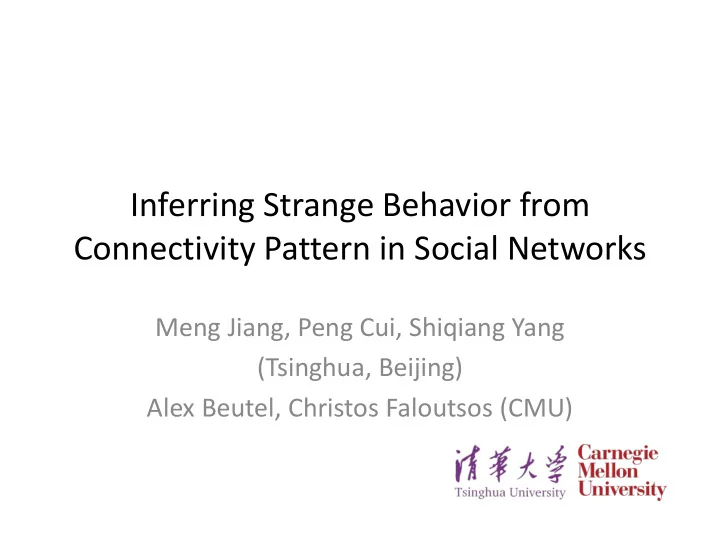

Inferring Strange Behavior from Connectivity Pattern in Social Networks Meng Jiang, Peng Cui, Shiqiang Yang (Tsinghua, Beijing) Alex Beutel, Christos Faloutsos (CMU)
What is Strange Behavior? • “Who -follows- whom” network with billions of edges: Twitter, Weibo, etc.
What is Strange Behavior? • Sell followers: “Become a Twitter Rockstar ” $ $ $ 0.9 TWD per edge
What is Strange Behavior? customer botnet $ connect $ 100 1,000 $
What is Strange Behavior? customer botnet $ connect $ 100 1,000 $ #follower ↑ +1,000
What is Strange Behavior? customer botnet $ connect $ 100 1,000 $ Unsafe! M ore customers… 100
What is Strange Behavior? customer botnet $ connect $ 100 1,000 $ M ore customers… connect 100 5,000
What is Strange Behavior? customer botnet $ connect $ 100 1,000 $ I want more followers… connect 100 5,000
What is Strange Behavior? customer botnet $ connect $ 100 1,000 $ connect connect 100 5,000
What is Strange Behavior? customer botnet $ connect 1,000 100 $ 100 5,000 $ …. …. More groups of customers More groups of botnets More companies….
What is Strange Behavior? customer botnet $ connect $ $ Detect dense biparitite cores! How can we evade detection? Some other activity!
What is Strange Behavior? customer botnet $ connect $ $ “Camouflage”: may connect to popular idols to look normal
What is Strange Behavior? customer botnet $ connect $ $ “Fame”: may have a few honest followers
Adjacency Matrix Reminder followee follower Graph Structure Adjacency Matrix
Strange Lockstep Behavior customer botnet connect camouflage • Groups fame • Acting together • Little other activity
More Applications • eBay reviews
More Applications • Facebook “Likes”
Problem Definition • Given adjacency matrix reordering • Find Strange = “Lockstep” Behavior
Outline • Method – SVD Reminder – “Spectral Subspace Plot” – BP-based Algorithm • Experiments – Dataset – Real Data – Synthetic Data
SVD Reminder followee 1 follower follow 2 Graph Structure Adjacency Matrix SVD: A=USV T Pairs of singular vectors: followee U 2 V 2 U 1 U 2 V 1 V 2 follower U 1 V 1 “Spectral Subspace Plot”
Outline • Method – SVD Reminder – “Spectral Subspace Plot” – BP-based Algorithm • Experiments – Dataset – Real Data – Synthetic Data
Lockstep and Spectral Subspace Plot • Case #0: No lockstep behavior in random power law graph of 1M nodes, 3M edges • Random “Scatter” Adjacency Matrix Spectral Subspace Plot
Lockstep and Spectral Subspace Plot • Case #1: non-overlapping lockstep • “Blocks” “Rays” Adjacency Matrix Spectral Subspace Plot
Lockstep and Spectral Subspace Plot • Case #2: non-overlapping lockstep • “Blocks; low density” Elongation Adjacency Matrix Spectral Subspace Plot
Lockstep and Spectral Subspace Plot • Case #3: non-overlapping lockstep • “ Camouflage ” (or “Fame”) Tilting “Rays” Adjacency Matrix Spectral Subspace Plot
Lockstep and Spectral Subspace Plot • Case #3: non-overlapping lockstep • “Camouflage” (or “ Fame ”) Tilting “Rays” Adjacency Matrix Spectral Subspace Plot
Lockstep and Spectral Subspace Plot • Case #4: ? lockstep • “?” “Pearls” Adjacency Matrix Spectral Subspace Plot ?
Lockstep and Spectral Subspace Plot • Case #4: overlapping lockstep • “ Staircase ” “Pearls” Adjacency Matrix Spectral Subspace Plot
Outline • Method – SVD Reminder – “Spectral Subspace Plot” – BP-based Algorithm • Experiments – Dataset – Real Data – Synthetic Data
Algorithm • Step 1: Seed selection – Spot “Rays” and “Pearls” – Catch seed followers • Step 2: Belief Propagation – Blame followees with strange followers – Blame followers with strange followees
Automatically Spot “Rays” and “Pearls” Spectral Polar Coordinate Histograms Subspace Plot Transform
BP-based Algorithm • Blame followees with strange followers • Blame followers with strange followees
Outline • Method – SVD Reminder – “Spectral Subspace Plot” – BP-based Algorithm • Experiments – Dataset – Real Data – Synthetic Data
Dataset • Tencent Weibo • 117 million nodes (users) • 3.33 billion directed edges
Outline • Method – SVD Reminder – “Spectral Subspace Plot” – BP-based Algorithm • Experiments – Dataset – Real Data – Synthetic Data
Real Data “Block” “Rays” “Pearls” “Staircase”
Real Data “Rays” “Block”
Real Data “Pearls” 3,188 7,210 2,457 in F 1 in F 2 in F 3 “Staircase” E 1 E 2 E 3 E 4 “F - E” F 1 - … F 2 - … F 3 - … Density 91.3% 92.6% 89.1%
Real Data “Pearls” “Staircase” “Staircase”
Real Data • Spikes on the out-degree distribution
Outline • Method – SVD Reminder – “Spectral Subspace Plot” – BP-based Algorithm • Experiments – Dataset – Real Data – Synthetic Data
Synthetic Data • Inject lockstep behavior with “ camouflage ” perfect
Synthetic Data • Inject overlapping lockstep behavior perfect
Contributions • Different types of lockstep behavior • A handbook (rules) to infer lockstep behavior with connectivity patterns • An algorithm to catch the suspicious nodes • Remove spikes on out-degree distribution
Thank you!
Recommend
More recommend